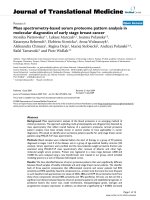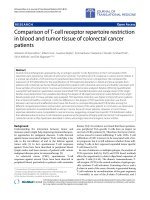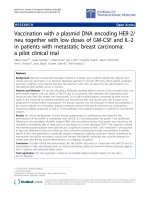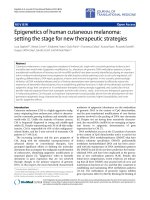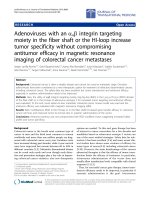Báo cáo hóa học: " Sexually transmitted Human Papillomavirus type variations resulting in high grade cervical dysplasia in North-East North Dakota and North-West Minnesota" pot
Bạn đang xem bản rút gọn của tài liệu. Xem và tải ngay bản đầy đủ của tài liệu tại đây (258.89 KB, 4 trang )
BioMed Central
Page 1 of 4
(page number not for citation purposes)
Virology Journal
Open Access
Short report
Sexually transmitted Human Papillomavirus type variations
resulting in high grade cervical dysplasia in North-East North
Dakota and North-West Minnesota
Lata Balakrishnan
1
, Ryan Clauson
2
, Timothy Weiland
3
, Michelle Bianco
4
and
Barry Milavetz*
1
Address:
1
Department of Biochemistry and Molecular Biology, University of North Dakota, Grand Forks, ND, USA,
2
School of Medicine,
University of North Dakota, Grand Forks, ND, USA,
3
Department of Pathology, University of North Dakota, Grand Forks, ND, USA and
4
School
of Medicine, University of Iowa, IA, USA
Email: Lata Balakrishnan - ; Ryan Clauson - ;
Timothy Weiland - ; Michelle Bianco - ;
Barry Milavetz* -
* Corresponding author
Abstract
Background: A review of Pap smear diagnoses from a reference laboratory in Grand Forks,
North Dakota over a 3-year period (07/00 to 10/03) revealed a two-fold higher rate of high grade
squamous intraepithelial lesion in a community in northwest Minnesota (Roseau, 0.486%) than in
northeast North Dakota (Grand Forks, 0.249%), in spite of both having similar rates of low-grade
squamous intraepithelial lesion (1.33% vs.1.30% respectively)
Objectives: To identify the different types of HPV present in patient populations showing high-
grade dysplasia in Grand Forks, ND and Roseau, MN.
Study design: Formaldehyde-fixed paraffin-embedded cervical tissue samples were analyzed using
polymerase chain reaction (PCR) to detect the presence of HPV type 16, 18 and 31.
Results: Our studies showed that 41 % of samples from Roseau were triply infected with HPV
serotypes 16, 18 and 31 in comparison to 12 % from Grand Forks.
Conclusion: Due to the small sample size we were unable to prove the study to be statistically
significant. However, our results suggest that the presence of HPV 16, 18 and 31 in triply infected
samples may be the cause of the higher percentage of high-grade dysplasia in Roseau, MN when
compared to Grand Forks, ND.
Background
Human Papillomavirus (HPV), a member of the papova-
virus family, is a small circular double stranded DNA virus
with a genome of approximately 8 Kb. HPV causes the
most common sexually transmitted disease (STD) in the
U.S. with at least 5.5 million new infections each year and
an actively infected population of approximately 20 mil-
lion people [1]. There are more than 100 different geno-
types of HPV, which are known to cause a wide range of
infections including common warts, genital warts, recur-
Published: 15 June 2006
Virology Journal 2006, 3:46 doi:10.1186/1743-422X-3-46
Received: 18 April 2006
Accepted: 15 June 2006
This article is available from: />© 2006 Balakrishnan et al; licensee BioMed Central Ltd.
This is an Open Access article distributed under the terms of the Creative Commons Attribution License ( />),
which permits unrestricted use, distribution, and reproduction in any medium, provided the original work is properly cited.
Virology Journal 2006, 3:46 />Page 2 of 4
(page number not for citation purposes)
rent respiratory papillomatosis, cervical dysplasia and cer-
vical cancer. Fifteen HPV types are classified as high-risk
types {16, 18, 31, 33, 35, 39, 45, 51, 52, 56, 58, 59, 68,
73, and 82} and twelve are classified as low-risk types {6,
11, 40, 42, 43, 44, 54, 61, 70, 72, 81, and CP6108} [2].
HPV has been found in 99.7 % of cervical carcinomas
worldwide with HPV 16 and 18 the predominant geno-
type in these carcinomas. [3]. The virus has been postu-
lated to gain entry into the body through microscopic
abrasions of the surface epithelium most often followed
by integration of the viral genomes of the high-risk types
into basal cells late in infection and subsequent transfor-
mation of the basal cells.
During an analysis of the severity of cervical dysplasia in
patients attending clinics in Grand Forks, ND and Roseau,
MN, we observed that the number of patients with high-
grade dysplasia was approximately twice as high in
Roseau compared to Grand Forks [0.249% and 0.486%
respectively; (p < 0.004)] in spite of similar rates of low-
grade dysplasia [1.304% and 1.332% respectively] in both
these areas. Grand Forks, ND and Roseau, MN are geo-
graphically related areas separated by approximately 100
miles. Since none of the typical risk factors including age
of 18–28, pregnancy, smoking, high school diploma or
less, use of oral contraceptive pills, or presence of coexist-
ing STD (including condylomata acuminata) correlated
with the increased incidence of high grade dysplasia, we
hypothesized that the increased incidence might be a
result of differences in the high-risk HPV types responsible
for the infections. The aim of this study was to use
polymerase chain reaction (PCR) to identify HPV types
16, 18 and 31 present in patient populations showing
high-grade dysplasia in Grand Forks, ND and Roseau,
MN.
Materials and methods
Study population
Archival paraffin-embedded, formalin-fixed cervical tis-
sue samples from patients diagnosed with high-grade dys-
plasia were obtained from Altru Clinic, Roseau, MN and
Altru Clinic, Grand Forks, ND over a three year period
from 07/00 – 10/03. Grand Forks represented the control
group, while Roseau, MN represented the experimental
group. Statistical significance was analyzed by Chi square
test and confirmed by z test using Sigma Stat software.
HPV type analyses
DNA from formaldehyde-fixed paraffin-embedded tissues
was extracted using the thermal cycler deparaffinization
method as previously described [4] with minor modifica-
tions. Extracted DNA preparations were first subjected to
PCR targeting a 155 base pair fragment (GP 5+/GP6+) of
the L1 open reading frame (ORF) of HPV [5]. The HPV
types in the positive samples were characterized by PCRs
specific for HPV types 16, 18, and 31 {Primer Sets used,
Type Specific 16 [6], Type Specific 18 [7], Type Specific 31
[8]. The final 30 μl of PCR mixture contained 2.5 μl sam-
ple, 2.0 mM MgCl
2
, 3 μl of 10X PCR Gold Buffer, 200 μM
deoxynucleoside triphosphates, 50 pmol of each primer
(IDT Oligos) and 0.5 μl AmpliTaq Gold Polymerase (all
reagents were purchased from Applied Biosystems, Foster
City, CA). The amplification conditions were set to 1 min
of denaturation at 95°C, 2 min of annealing at 40°C and
1.5 min of extension at 72°C for 40 cycles. HeLa and
CaSki cells were used as positive controls for HPV 18 and
HPV 16 respectively. The presence of an appropriately
sized amplification product was monitored by gel electro-
phoresis and ethidium bromide staining.
Results and discussion
Out of the total thirty-four high-grade cervical dysplasia
tissues analyzed by PCR with the general primers (GP 5+/
GP 6+) targeting a 155 base pair fragment of the L1 open
reading frame of HPV, twenty-eight tested positive. Sam-
ples from four normal patients, which were used as nega-
tive controls, did not show any evidence of HPV infection.
Since the general primers have previously been reported
to be less sensitive than specific primers in screening for
certain high-risk HPV types [9], all of the samples were
then amplified with primer sets specific to each of the
three different high-risk types (HPV 16, 18 and 31) which
are known to be associated with cervical carcinoma (Wal-
boomers et al., 1999). Of the 17 cases studied from Grand
Forks – control group, 14 samples (82 %) were positive
for the general primers (Figure 1). Two samples (12 %)
and 3 samples (18 %) were positive for only HPV types 16
and 18 respectively. There were no cases with single infec-
tion with HPV types 31. Three samples (18 %) showed
dual infections with both HPV 16 and 18, 1 sample (6 %)
were doubly infected with HPV 16 and 31 and 4 samples
(24 %) were doubly infected with HPV 18 and 31. Two
samples (12 %) showed triple infections with HPV 16,18
and 31. One sample tested negative with general primers
but tested positive with HPV 18 specific primers.
Of the 17 cases studied from Roseau – experimental
group, 14 samples (82%) were positive for the general
primers (Figure 1). Single infections of HPV 18 were not
detected. One sample (6%) had single infections with
HPV 16 and 2 samples (12 %) with HPV 31. Two samples
(12%) were doubly infected with HPV 16 and 18, 3 sam-
ples (18 %) with HPV 16 and 31 and 1 sample 6 % with
HPV 18 and 31. Triple infections with HPV 16,18 and 31
were detected in 7 samples (41 %) cases. One sample
tested negative with general primers but tested positive
with HPV 31 specific primers.
We also analyzed four squamous cell carcinoma tissue
samples from Roseau, MN and all the four samples tested
Virology Journal 2006, 3:46 />Page 3 of 4
(page number not for citation purposes)
positive with the general primers for HPV. We further ana-
lyzed these samples for the presence of specific types of
HPV and found that three out of the four samples were tri-
ply infected with HPV type 16, 18 and 31. One sample
contained a double infection with HPV 16 and 31.
Differences in the incidence of cervical high-grade dyspla-
sia in two separate communities within the same geo-
graphic area were correlated with the presence of multiple
HPV type infections and differences in the HPV type
infecting the dysplastic cells. Multiple infections with dif-
ferent HPV types have been previously reported to be
associated with high-grade dysplasia [10,11]. Infection
with HPV 16 has also been known to cause high-grade
squamous intraepithelial lesions which progress into
malignancy [12]. However, in our study population we
found that the presence of single or double infections
with HPV 16 did not alone appear to contribute to the
higher incidence rate of high-grade dysplasia. Our results
suggest that the presence of HPV types 16 and 18 along
with HPV 31 in the triply infected samples may be respon-
sible for the higher rate of HSIL in the experimental pop-
ulation. Supporting this hypothesis was the observation
that 3 of 4 samples of cervical squamous cells carcinoma
from area patients also were triply infected with HPV 16,
18, and 31 suggesting that the presence of multiple infec-
tions along with HPV 16 might play a significant role in
the progression of low-grade dysplasias to high-grade dys-
plasia. However due to the small sample size tested, this
data precludes any statistical significance. Although we
analyzed all of the samples obtained from Roseau MN
over a three year period, we realize that this analysis was
limited by the relatively small number of samples which
could be obtained from this location. However, it was
quite interesting that major differences in HPV type infect-
ing cervical tissue could exist in distinct localities within
the same geographic area. Similarly since we only ana-
lyzed for HPV 16, 18 and 31, we do not know if other viral
types were present in single or multiple infections. Confir-
mation of the role of triple infections by HPV types in
causing high-grade dysplasias will require further molecu-
lar studies in a larger risk population.
Competing interests
The author(s) declare that they have no competing inter-
ests.
Authors' contributions
LB conducted the HPV analyses and wrote the manuscript.
RC helped in the HPV PCR analyses. TW provided the
archival tissue samples. MB was instrumental in getting
the project started and doing some background research.
BM coordinated the research efforts at UND and edited
the manuscript. All co-authors read and approved the
final manuscript.
Acknowledgements
We would like to acknowledge Dr Manuchair Ebadi for funding this
research project. We would also like to thank Dr Matthew Nilles and Dr
Luis Padilla for providing us with HeLa and CaSki cells respectively.
References
1. Cates WJ: Estimates of the incidence and prevalence of sexu-
ally transmitted diseases in the United States. American
Social Health Association Panel. Sex Transm Dis 1999, 26:S2-7.
2. Munoz N, Bosch FX, de Sanjose S, Herrero R, Castellsague X, Shah
KV, Snijders PJ, Meijer CJ: Epidemiologic classification of human
papillomavirus types associated with cervical cancer. N Engl
J Med 2003, 348:518-527.
3. Walboomers JM, Jacobs MV, Manos MM, Bosch FX, Kummer JA, Shah
KV, Snijders PJ, Peto J, Meijer CJ, Munoz N: Human papillomavirus
is a necessary cause of invasive cervical cancer worldwide. J
Pathol 1999, 189:12-19.
4. Coombs N.J. GACPJN: Optimisation of DNA and RNA extrac-
tion from archival formalin-fixed tissue. Nucleic Acids Research
1999, 27:e12.
5. Snijders PJ, van den Brule AJ, Schrijnemakers HF, Snow G, Meijer CJ,
Walboomers JM: The use of general primers in the polymerase
chain reaction permits the detection of a broad spectrum of
human papillomavirus genotypes. J Gen Virol 1990, 71 ( Pt
1):173-181.
6. Falcinelli CECBKWGVQ: Detection of the human papilloma
virus type 16 mRNA-transcripts in cytological abnormal
scrapings. J Med Virol 1992, 37:93-98.
7. Melchers WJGAJCBJMMWMBMBPHJLWGVQ: ncreased detec-
tion rate of human papillomavirus in cervical scrapes by the
polymerase chain reaction as compared to modified FISH
and southern blot analysis. J Med Virol 1989, 27:329-335.
8. van der Brule AJCPJFSRLIGOPBCJLMMJMMW: General primer
mediated polymerase chain reaction permits the detection
of sequenced and still unsequenced human papillomavirus
HPV Infection in Grand Forks, ND (control group) versus Roseau, MN (experimental group)Figure 1
HPV Infection in Grand Forks, ND (control group)
versus Roseau, MN (experimental group). Cervical tis-
sue samples from patients from Grand Forks, ND (control
group) and Roseau, MN (experimental group) were analyzed
for the presence of different high-risk HPV infections. All
samples were first analyzed with general primers (GP) and
subsequently analyzed with type-specific (TS) primers. Vary-
ing incidence of type-specific HPV infections are presented as
a comparison between infection in Grand Forks, ND and
Roseau, MN.
Publish with BioMed Central and every
scientist can read your work free of charge
"BioMed Central will be the most significant development for
disseminating the results of biomedical research in our lifetime."
Sir Paul Nurse, Cancer Research UK
Your research papers will be:
available free of charge to the entire biomedical community
peer reviewed and published immediately upon acceptance
cited in PubMed and archived on PubMed Central
yours — you keep the copyright
Submit your manuscript here:
/>BioMedcentral
Virology Journal 2006, 3:46 />Page 4 of 4
(page number not for citation purposes)
genotyes in cervical scrapes and carcinomas. IntJCancer 1990,
45:644-649.
9. Arbyn Marc JJBDDSJDJJEMPNJPORGRUSPSAEW: Methods and
techniques of cervical screening. 2003.
10. Cuschieri KS, Cubie HA, Whitley MW, Seagar AL, Arends MJ, Moore
C, Gilkisson G, McGoogan E: Multiple high risk HPV infections
are common in cervical neoplasia and young women in a cer-
vical screening population. J Clin Pathol 2004, 57:68-72.
11. Fife KH, Cramer HM, Schroeder JM, Brown DR: Detection of mul-
tiple human papillomavirus types in the lower genital tract
correlates with cervical dysplasia. J Med Virol 2001, 64:550-559.
12. Bornstein J RMAAH: Etiology of cervical cancer: current con-
cepts. Obstet Gynecol Surv 1995, 50:146-154.


